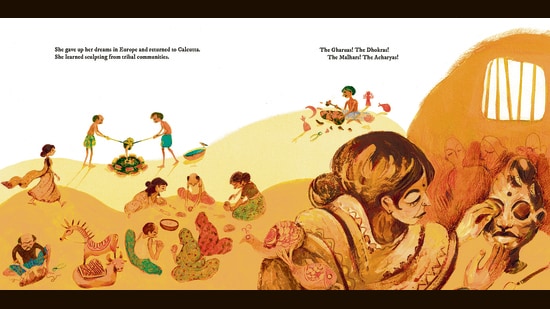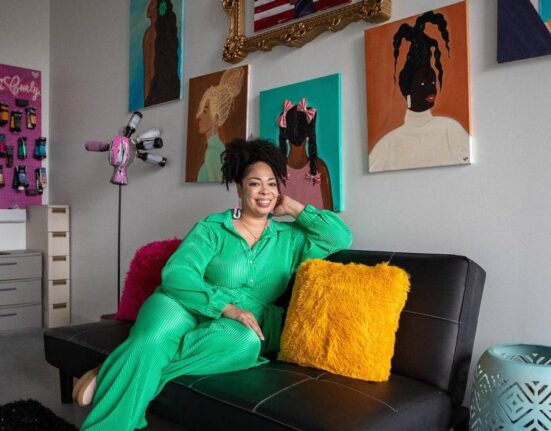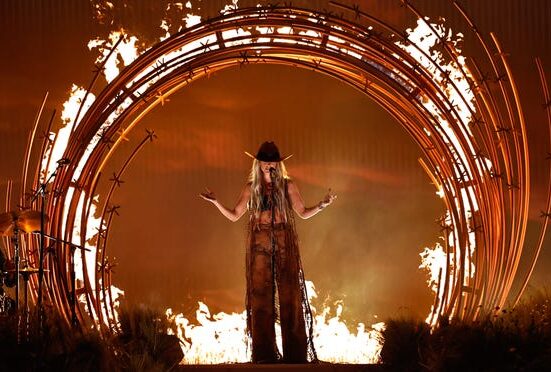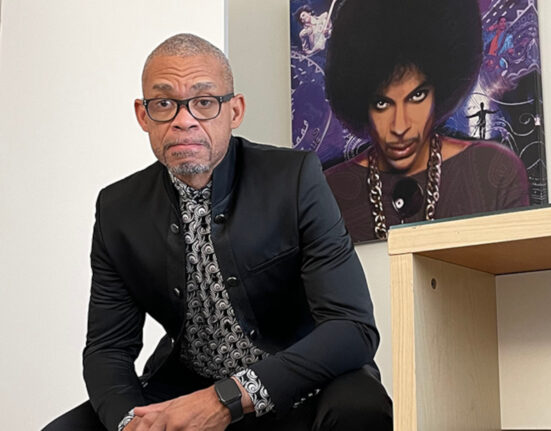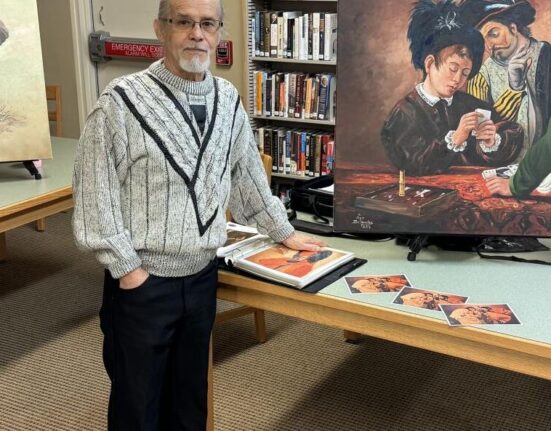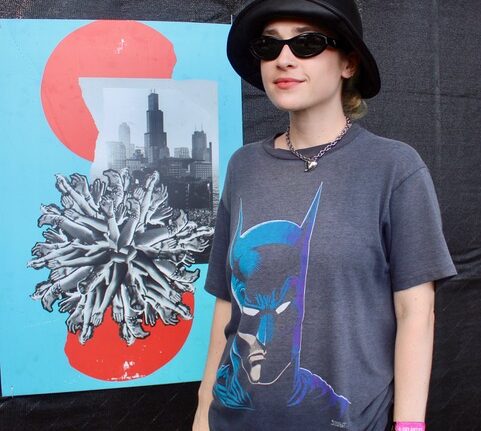It’s like a door into the past, left ajar.

New books aimed at children are unwrapping the lives of some of India’s most renowned artists, with a special focus on their childhoods.
The aim is to allow children to really see how an artist thinks, says Vaishali Shroff, author of one such book on the sculptor Meera Mukherjee.
Other works include The Secret World of Mehlli Gobhai (Pratham Books; 2021), which tells the story of a boy who found art in everything, even in the way a street vendor arranged his combs for sale. Written by Jerry Pinto, it explores, among other things, how Gobhai embraced mistakes.
As the artist once told Pinto: “A mistake can show you what you wanted to do, or it can show you what could be done if you let go.”
In Prince with a Paintbrush (Red Panda; 2021), Shobha Tharoor Srinivasan and illustrator Rayika Sen tell the story of how Raja Ravi Varma began his career with doodles on the walls of his home.
Meanwhile, a series released by art education platform Art1st explores the childhoods of Indian masters such as Ganesh Pyne (2024), Jamini Roy (2023), Somnath Hore (2021), Abanindranath Tagore (2022) and sculptor Meera Mukherjee (2023).
“Through the lives of these artists, the aim is to gently nudge children to question and explore what they see, hear and experience, reassess what art means to them, and form a bond with it in a playful manner,” says Senalda Ronald, editor and coordinator at the arts-education platform Art1st.
The books are interactive as well, in ways that, like the stories, are aimed at young ones but offer plenty for adults too. DIY activities invite the reader to try to sketch in the artist’s style, or pop out perforated sheets to create works in mixed-media.
It’s about time we took this step in India, says Jerry Pinto. Art is so wrapped in a bubble of exclusivity, he says, that for far too long, inspiring biographies have been largely limited to scientists, politicians, sportspersons, even storytellers, but not artists.
Yet art matters, adds Likla Lall, author of the book on Somnath Hore. In that work, we meet a shy, sensitive boy who can’t look away from a wound, and ends up etching it into his art.
The hope is that such stories can help channel children’s empathy, quirky interests and unusual talents, she says.
After all, “children learn to doodle so early. Books like these can help them develop a sense of wonder, art appreciation, and critical thinking, from an early age.”
A myth-maker rises in Kerala

A little boy is painting on a wall, as his friends play hopscotch nearby. That’s how we meet seven-year-old Ravi Varma, in Prince with a Paintbrush (Red Panda; 2021), written by Shobha Tharoor Srinivasan and illustrated by Rayika Sen.
Varma learnt to make his own pigments as a child, from flowers, leaves, soil and tree bark. He was lucky to have encouragement from his uncle, the painter Rajaraja Varma, the book notes.
Raja Ravi Varma (1848-1906) later trained under the palace painter of the Maharaja of Travancore, in present-day Kerala, and under the Danish-British artist Theodor Jenson.
As his work travelled the world, it retained his signature style: a blend of European technique and local aesthetic. His subjects were life-like; caught in natural settings. They looked, as the book puts it, as if they might step right off the canvas. He was so successful in his lifetime that the title of Raja was bestowed on him by the then-viceroy, Lord Curzon, in 1904.
Srinivasan had long wanted to write such a book, she says. As a children’s author interacting with young people across the country, she noticed that many were familiar with the work of European masters such as Leonardo da Vinci and Vincent van Gogh. “So many hadn’t even heard of Raja Ravi Varma,” she says.
Filled with reproductions of his art, her book aims to bridge this gap.
“I want his luminous oil paintings to become as familiar to children,” Srinivasan says, “as Monet’s Water Lilies or van Gogh’s Starry Night.”
Art that grew from rice paste
Sculptor Meera Mukherjee’s (1923-1998) initiation into art began at the door of her childhood home in Kolkata. She and her mother would sit at the threshold on festive days, and create patterns with alpona or rice-flour paste.
“‘Why do we make alponas if the ants will eat the rice paste anyway?’ she asked her Maa,” the book recounts. “We make them for the ants,” the mother responds.
Meera Mukherjee: Breaking Moulds (Art1st and KNMA; 2023), written by Vaishali Shroff and illustrated by Shivam Choudhary, paints a portrait of an unusual girl who processes her world — the ebb and flow of a river, the swish of leaves, the colours of the sky — through her art.
At first, this art consists of paintings. After touring the world and studying and exhibiting her work in cities such as Munich, London and Paris, she finds herself questioning what any of it means. Her heart filled with images of the impoverished in a newly independent India, she returns home, unable to paint anymore. She takes up the chisel, and decides to create art that challenges.
She works with and learns from tribal sculptors, fisherfolk, weavers. She chisels their big eyes, large feet and long hands into her work.
“The imperfect strokes on Meera’s sculptures were a celebration of people’s struggles,” the book notes. “Their scars became her scars. Their lives, her lives.”
Ghosts that lit a fuse

House Number 5 in Jorasanko, North Kolkata, is a towering, red stone structure that’s hard to miss. There is often something of a crowd around it too, as people line up to visit the family estate of poet, playwright, composer and Nobel laureate Rabindranath Tagore.
Growing up here in the 1870s, however, Tagore’s nephew Abanindranath Tagore (1871-1951) just found the house creepy.
“Aban hated the tricks Jorasanko played on him, turning floors into oceans and beds into boats… On a bad day, Aban felt like Jorasanko would swallow him whole,” notes Abanindranath’s House of Stories (Art1st and KNMA; 2022), written by Likla Lall and illustrated by Eva Sanchez Gomez.
He eventually defeated the shadows using the power of his imagination. He made up stories about the adventures that likely unfolded in the spooky corridors, involving generations of Tagores that came before him.
He began to write, sketch and paint his stories, featuring aunts and uncles, sweepers and gardeners. He transformed the place he feared.
He would go on, of course, to co-found the Bengal School of Art.
Gomez’s illustrations capture shadows, djinns and storms in striking black-and-white, before the book moves on to reproduce some of Tagore’s best-known works: the Bharat Mata series, Arabian Nights series, Katam Kutum miniature puppet series.
It’s a tribute to a young artist’s ability to personify things, ideas, even fears. And with that gift, “Jorasanko no longer felt like a haunting prison,” the book notes, “but a mansion of stories.”
Shape-shifters caught on canvas

Even as a child, he saw art in everything: in bare trees, muddy streams, and the way a street vendor arranged his combs on a pavement.
In The Secret World of Mehlli Gobhai (Pratham Books; 2021), written by Jerry Pinto and illustrated by Kripa B, the reader meets the boy as he shifts from home to home in the 1930s, in British-ruled Bombay.
His life is made up of a strange mosaic of elements. At one point, Gobhai (1931-2018) shelters a slow loris; he leaves to study in London; works in New York; returns to craft copy for Air India ads.
Through it all, the book explores how he embraced mistakes. “A mistake can show you what you wanted to do, or it can show you what could be done if you let go,” the artist once told Pinto.
The book guides the reader through some of the abstractionist’s best-known works.
“Can you see the Nandi Bull, the mount of Lord Shiva? Look for the horns and the hump. See how the image suddenly jumps out at you?… Look and look again… untrain your eyes and set your mind free,” Pinto writes.
The Secret World… became a way to introduce young readers to “a different mind” and to the idea that there is no right or wrong in art, Pinto says.
“So many of us adults have this idea that appreciating art means having to explain it to yourself and others. But it really is about just opening your mind and heart to it and waiting for something to happen,” he adds.
Some works might not stir us. But some will. “And that can feel magical, can’t it?”

